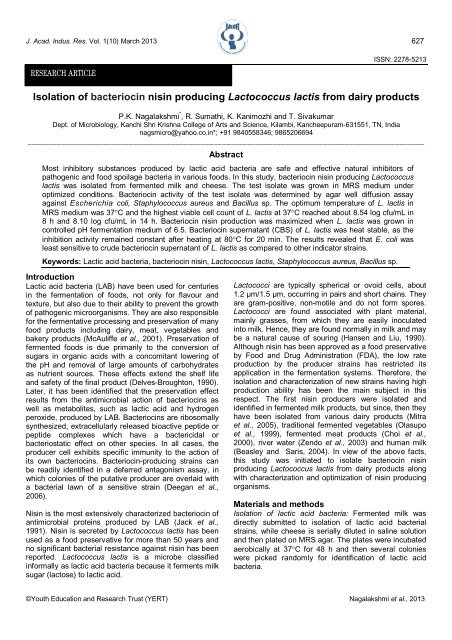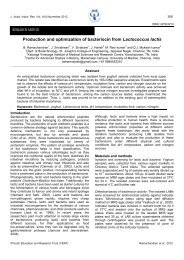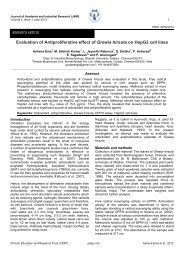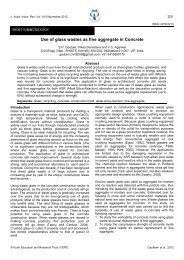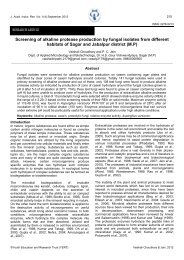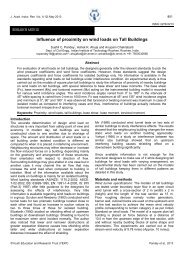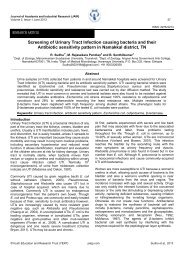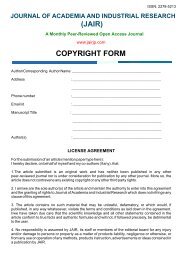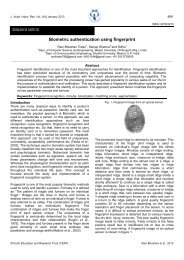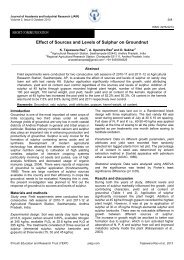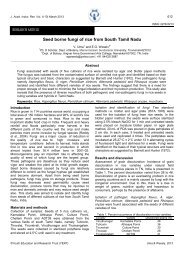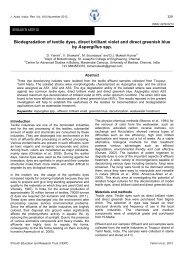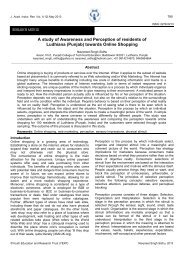Isolation of bacteriocin nisin producing Lactococcus lactis from dairy ...
Isolation of bacteriocin nisin producing Lactococcus lactis from dairy ...
Isolation of bacteriocin nisin producing Lactococcus lactis from dairy ...
Create successful ePaper yourself
Turn your PDF publications into a flip-book with our unique Google optimized e-Paper software.
J. Acad. Indus. Res. Vol. 1(10) March 2013 627RESEARCH ARTICLEISSN: 2278-5213<strong>Isolation</strong> <strong>of</strong> <strong>bacteriocin</strong> <strong>nisin</strong> <strong>producing</strong> <strong>Lactococcus</strong> <strong>lactis</strong> <strong>from</strong> <strong>dairy</strong> productsP.K. Nagalakshmi * , R. Sumathi, K. Kanimozhi and T. SivakumarDept. <strong>of</strong> Microbiology, Kanchi Shri Krishna College <strong>of</strong> Arts and Science, Kilambi, Kancheepuram-631551, TN, Indianagsmicro@yahoo.co.in*; +91 9840558346; 9865206694______________________________________________________________________________________________AbstractMost inhibitory substances produced by lactic acid bacteria are safe and effective natural inhibitors <strong>of</strong>pathogenic and food spoilage bacteria in various foods. In this study, <strong>bacteriocin</strong> <strong>nisin</strong> <strong>producing</strong> <strong>Lactococcus</strong><strong>lactis</strong> was isolated <strong>from</strong> fermented milk and cheese. The test isolate was grown in MRS medium underoptimized conditions. Bacteriocin activity <strong>of</strong> the test isolate was determined by agar well diffusion assayagainst Escherichia coli, Staphylococcus aureus and Bacillus sp. The optimum temperature <strong>of</strong> L. <strong>lactis</strong> inMRS medium was 37C and the highest viable cell count <strong>of</strong> L. <strong>lactis</strong> at 37C reached about 8.54 log cfu/mL in8 h and 8.10 log cfu/mL in 14 h. Bacteriocin <strong>nisin</strong> production was maximized when L. <strong>lactis</strong> was grown incontrolled pH fermentation medium <strong>of</strong> 6.5. Bacteriocin supernatant (CBS) <strong>of</strong> L. <strong>lactis</strong> was heat stable, as theinhibition activity remained constant after heating at 80C for 20 min. The results revealed that E. coli wasleast sensitive to crude <strong>bacteriocin</strong> supernatant <strong>of</strong> L. <strong>lactis</strong> as compared to other indicator strains.Keywords: Lactic acid bacteria, <strong>bacteriocin</strong> <strong>nisin</strong>, <strong>Lactococcus</strong> <strong>lactis</strong>, Staphylococcus aureus, Bacillus sp.IntroductionLactic acid bacteria (LAB) have been used for centuriesin the fermentation <strong>of</strong> foods, not only for flavour andtexture, but also due to their ability to prevent the growth<strong>of</strong> pathogenic microorganisms. They are also responsiblefor the fermentative processing and preservation <strong>of</strong> manyfood products including <strong>dairy</strong>, meat, vegetables andbakery products (McAuliffe et al., 2001). Preservation <strong>of</strong>fermented foods is due primarily to the conversion <strong>of</strong>sugars in organic acids with a concomitant lowering <strong>of</strong>the pH and removal <strong>of</strong> large amounts <strong>of</strong> carbohydratesas nutrient sources. These effects extend the shelf lifeand safety <strong>of</strong> the final product (Delves-Broughton, 1990).Later, it has been identified that the preservation effectresults <strong>from</strong> the antimicrobial action <strong>of</strong> <strong>bacteriocin</strong>s aswell as metabolites, such as lactic acid and hydrogenperoxide, produced by LAB. Bacteriocins are ribosomallysynthesized, extracellularly released bioactive peptide orpeptide complexes which have a bactericidal orbacteriostatic effect on other species. In all cases, theproducer cell exhibits specific immunity to the action <strong>of</strong>its own <strong>bacteriocin</strong>s. Bacteriocin-<strong>producing</strong> strains canbe readily identified in a deferred antagonism assay, inwhich colonies <strong>of</strong> the putative producer are overlaid witha bacterial lawn <strong>of</strong> a sensitive strain (Deegan et al.,2006).Nisin is the most extensively characterized <strong>bacteriocin</strong> <strong>of</strong>antimicrobial proteins produced by LAB (Jack et al.,1991). Nisin is secreted by <strong>Lactococcus</strong> <strong>lactis</strong> has beenused as a food preservative for more than 50 years andno significant bacterial resistance against <strong>nisin</strong> has beenreported. <strong>Lactococcus</strong> <strong>lactis</strong> is a microbe classifiedinformally as lactic acid bacteria because it ferments milksugar (lactose) to lactic acid.Lactococci are typically spherical or ovoid cells, about1.2 µm/1.5 µm, occurring in pairs and short chains. Theyare gram-positive, non-motile and do not form spores.Lactococci are found associated with plant material,mainly grasses, <strong>from</strong> which they are easily inoculatedinto milk. Hence, they are found normally in milk and maybe a natural cause <strong>of</strong> souring (Hansen and Liu, 1990).Although <strong>nisin</strong> has been approved as a food preservativeby Food and Drug Administration (FDA), the low rateproduction by the producer strains has restricted itsapplication in the fermentation systems. Therefore, theisolation and characterization <strong>of</strong> new strains having highproduction ability has been the main subject in thisrespect. The first <strong>nisin</strong> producers were isolated andidentified in fermented milk products, but since, then theyhave been isolated <strong>from</strong> various <strong>dairy</strong> products (Mitraet al., 2005), traditional fermented vegetables (Olasupoet al., 1999), fermented meat products (Choi et al.,2000), river water (Zendo et al., 2003) and human milk(Beasley and Saris, 2004). In view <strong>of</strong> the above facts,this study was initiated to isolate <strong>bacteriocin</strong> <strong>nisin</strong><strong>producing</strong> <strong>Lactococcus</strong> <strong>lactis</strong> <strong>from</strong> <strong>dairy</strong> products alongwith characterization and optimization <strong>of</strong> <strong>nisin</strong> <strong>producing</strong>organisms.Materials and methods<strong>Isolation</strong> <strong>of</strong> lactic acid bacteria: Fermented milk wasdirectly submitted to isolation <strong>of</strong> lactic acid bacterialstrains, while cheese is serially diluted in saline solutionand then plated on MRS agar. The plates were incubatedaerobically at 37C for 48 h and then several colonieswere picked randomly for identification <strong>of</strong> lactic acidbacteria.©Youth Education and Research Trust (YERT) Nagalakshmi et al., 2013
J. Acad. Indus. Res. Vol. 1(10) March 2013 628The isolated colonies were further subcultured andtransferred to MRS slants incubated at 37C for 48 h andpreserved at 4C for further work.Morphological and biochemical tests: The isolates weregrouped as lactic acid bacteria after examining theirgram reaction, cell and colony morphology, catalasereaction and gas production <strong>from</strong> glucose fermentation.The test isolate LAB, <strong>Lactococcus</strong> <strong>lactis</strong> was used forfurther optimization process.Effect <strong>of</strong> heat treatment on bateriocin production:Aliquots (5 mL) <strong>of</strong> sterile CBS were heated at 70, 80, 90and 100C for 20 min in a thermostatically controlledwater bath and at 121C for 20 min in an autoclave. Thetreated samples were tested for antibacterial activityagainst the indicator bacterial strains. Untreated cultureconcentrated served as a positive control.Plate 1. Growth <strong>of</strong> L. <strong>lactis</strong> on MRS media.Optimum temperature for growth <strong>of</strong> L. <strong>lactis</strong>: <strong>Lactococcus</strong><strong>lactis</strong> culture was inoculated in 100 mL MRS broth at100 rpm in a shaking incubator at different temperaturesranging <strong>from</strong> 30, 35, 37 and 40C. Samples were takenevery hour for the first 12 h and then at 14, 16, 20 and24 h for enumeration <strong>of</strong> LAB in MRS agar and incubatedat 37C for 24-36 h.Controlled pH for growth <strong>of</strong> L. <strong>lactis</strong>: <strong>Lactococcus</strong> <strong>lactis</strong>strain was grown in MRS broth supplemented with2% yeast extract, 0.2% glucose and 0.2% meat extractincubated at 37C for 24 h. The pH <strong>of</strong> fermentation wasmaintained constantly at 6, 6.5 and 7 by addition <strong>of</strong>1 M NaOH and uncontrolled-pH fermentation was alsoinvestigated. Samples were taken every hour for the first12 h and then were taken at 14, 16, 20 and 24 h.Preparation <strong>of</strong> crude <strong>bacteriocin</strong> supernatant (CBS):Overnight cultures <strong>of</strong> L. <strong>lactis</strong> were inoculated to 25 mLMRS broth incubated at optimum temperature for12-16 h to reach stationary phase. The cultures wereprepared for CBS by centrifugation at 12,000 x g for20 min at 4C for determining <strong>bacteriocin</strong> activity by agarwell diffusion assay. The inhibition activity was reportedas diameter (mm) <strong>of</strong> a clear inhibition zone.Bacteriocin assay method by agar well diffusion:Bacteriocin screening was performed by well diffusionmethod. The target strains used in this study wereE. coli, S. aureus and Bacillus sp. and they weresubcultured in tryptone soy broth (TSB) for 24 h foractivation prior to antimicrobial activity. The antimicrobialactivities <strong>of</strong> the isolates were quantified by agar welldiffusion method. An isolated colony was selected <strong>from</strong>MRS agar plate culture and the growth is transferred intoa tube containing sterile MRS broth (5 mL), incubated at35C for 24 h. To get the culture filtrate, a 24 h culturewas centrifuged at 10,000 rpm for 20 min and heattreatment process was done. An actively growing testorganism in TSB <strong>of</strong> 24 h culture were dipped with asterile cotton swab and overlaid on MHA plates. Wells <strong>of</strong>approximately 6 mm were bored in the agar medium.The well was filled with culture filtrates. After 12-24 h <strong>of</strong>incubation, each plate was examined. The diameter <strong>of</strong>the zones <strong>of</strong> complete inhibition was examined, includingthe diameter <strong>of</strong> the well.Table 1. Physiological and biochemical characteristics <strong>of</strong> L. <strong>lactis</strong>.Colony morphologyRaised and circularCell morphologyCocciCell arrangementPairs and short chainsGram reactionPositiveSpore formationNegativeCatalase activityNegativeGlucose fermentationPositiveSalt tolerance testNaCl at 2%PositiveNaCl at 4%PositiveNaCl at 6.5%PositiveResultsA total <strong>of</strong> 120 colonies <strong>from</strong> the fermented food sampleswere examined, <strong>of</strong> which 12 colonies were recorded aspositive, <strong>producing</strong> inhibition zones on agar media.Of these colonies, only one strain No. 12 stably secretedinhibitory substances into culture broth. This <strong>bacteriocin</strong><strong>producing</strong> strain was gram positive, catalase-negative,coccus, non-motile and produced no gas <strong>from</strong> glucosewas potentially identified as <strong>Lactococcus</strong> <strong>lactis</strong> (Plate 1and Table 1). Optimum temperature <strong>of</strong> L. <strong>lactis</strong> growth inMRS broth was found to be 37C in 8 h (Table 2).When the pH <strong>of</strong> fermentation <strong>of</strong> L. <strong>lactis</strong> was constantlyheld at 6.0, 6.5, 7.0 and uncontrolled, at 37 o C then theviable cell counts <strong>of</strong> L. <strong>lactis</strong> and absorbance at 600 nmwere determined. Viable cell counts <strong>of</strong> L. <strong>lactis</strong> andabsorbance <strong>of</strong> fermented media during 24 h wasobserved. The maximum <strong>of</strong> absorbance (in term <strong>of</strong>absorbance reading at 600 nm) and bacterial growthwere observed at 8 h at pH <strong>of</strong> 6.5 (Table 3). Antimicrobialactivity <strong>of</strong> standard antibiotics was tested against E. coli,S. aureus and Bacillus sp. and degree <strong>of</strong> inhibitiontowards test organisms were given in Table 4.©Youth Education and Research Trust (YERT) Nagalakshmi et al., 2013
J. Acad. Indus. Res. Vol. 1(10) March 2013 629Table 2. Growth <strong>of</strong> L. <strong>lactis</strong> in MRS broth at different temperatures.TemperatureGrowth (OD at 600 nm)0 h 2 h 4 h 6 h 8 h 10 h 12 h 14 h 16 h 18 h 20 h 22 h 24 h30C 6.51 6.58 7.01 7.21 7.62 8.12 8.26 8.02 7.98 7.72 7.50 6.50 5.7135C 6.81 7.00 7.50 8.00 8.12 8.35 7.90 7.61 7.35 7.10 6.95 6.85 6.5037C 6.53 6.80 7.20 8.01 8.54 8.50 8.31 7.80 7.35 7.20 6.98 6.50 6.0040C 6.50 6.67 6.98 7.15 7.20 7.65 7.91 8.10 7.65 7.10 6.80 6.09 5.50Table 3. Growth <strong>of</strong> L. <strong>lactis</strong> in MRS broth at different pHs.pHGrowth (OD at 600 nm)0 h 2 h 4 h 6 h 8 h 10 h 12 h 14 h 16 h 18 h 20 h 22 h 24 h6.0 0.0 0.0 0.20 1.25 2.53 2.49 2.30 2.25 2.20 2.18 2.15 2.14 2.136.5 0.0 0.0 0.60 2.50 2.68 2.40 2.28 2.24 2.19 2.17 2.15 2.15 2.157.0 0.0 0.0 0.75 2.25 2.43 2.25 2.15 2.14 2.13 2.10 2.09 2.08 2.00Control 0.0 0.0 0.11 0.25 0.50 0.95 1.10 1.15 1.19 1.20 1.22 1.25 1.29In this study, maximum zone <strong>of</strong> inhibition was observedin cipr<strong>of</strong>loxin (31 mm) and minimum inhibitory <strong>of</strong> 11 mmobserved in streptomycin. The effect <strong>of</strong> heat treatment on<strong>bacteriocin</strong> activity was determined using the indicatorbacteria. The inhibitory substance produced by L. <strong>lactis</strong>was considered to be <strong>nisin</strong> and heat stable (Table 5 and6).DiscussionLactic acid bacteria isolated <strong>from</strong> fermented milkproducts includes Lactobacillus, <strong>Lactococcus</strong>,Pediococcus and Streptococcus. All LAB were subjectedto inhibitory activity test using agar well diffusion method.Girum et al. (2005) observed varying degree <strong>of</strong> inhibitionon various food borne pathogens by the culture filtrate <strong>of</strong>LAB. In this study, essentially it is noted that <strong>bacteriocin</strong>has a lytic bactericidal mode <strong>of</strong> action. There is aphysiological link between temperature, growth and <strong>nisin</strong>concentration. This may be due to the direct effect <strong>of</strong>temperature on microbial growth. Optimum temperature<strong>of</strong> L. <strong>lactis</strong> in MRS broth could be considered at 37C.The highest viable cell count <strong>of</strong> L. <strong>lactis</strong> at 37C reached8.54 log cfu/mL in 8 h, whereas incubation at 30, 35 and40C, the highest viable cell counts reached8.26 log cfu/mL in 11 h, 8.35 (9 h) and 8.10 log cfu/mL in14 h, respectively. It was obvious that the growth <strong>of</strong>L. <strong>lactis</strong> at 37C was better than at other temperatures.The optimum temperature at 37C falls in line with theprevious reports by Matsusaki et al. (1998) andBenkerroum et al. (2000). Crude <strong>bacteriocin</strong> supernatantproduced by L. <strong>lactis</strong> in controlled pH fermentationrevealed that <strong>bacteriocin</strong> production could be maximizedby maintaining the pH <strong>of</strong> growth media at 6.5. The effect<strong>of</strong> pH on <strong>bacteriocin</strong> production has been welldocumented where control <strong>of</strong> pH during growth results inhigher <strong>bacteriocin</strong> titers (Yang and Ray, 1994; Franzet al., 1997). Therefore, fermentation <strong>of</strong> <strong>bacteriocin</strong><strong>producing</strong> bacteria at controlled pH <strong>of</strong> 6.5 wasconsidered as more suitable than at pH 6 and 7.Decreasing <strong>of</strong> <strong>bacteriocin</strong> activities was observed at 11,14, 12 and 12 h for the fermented media at controlled pH<strong>of</strong> 6, 6.5, 7 and uncontrolled pH.Table 4. Antibiogram results <strong>of</strong> test strains withtraditional antibiotics.AntibioticsE. coli S. aureus Bacillus sp.(mm) (mm) (mm)Amikacin (30 µg) 20 23 25Gentamycin (10 µg) 21 20 21Streptomycin (10 µg) 20 20 11Cipr<strong>of</strong>loxin (5 µg) 31 25 24Table 5. Effect <strong>of</strong> heat treatment on <strong>bacteriocin</strong> activity byagar well diffusion method.Test organismBacteriocinHeat treatmentactivity(⁰C)(mm)70 2080 16E. coli90 12100 10121 08Control 2070 2380 21S. aureus90 18100 15121 10Control 2370 2580 23Bacillus sp.90 18100 15121 10Control 25Decrease in <strong>bacteriocin</strong> activity was observed during thelate <strong>of</strong> fermentation for both controlled and uncontrolledpH media. O’Keeffe and Hill (1999) described thisphenomenon due to the protein degradation, proteinaggregation and complex formation. Crude <strong>bacteriocin</strong>supernatant produced by L. <strong>lactis</strong> was considered to beheat stable, as the inhibition activity remained constantafter heating at 80C for 20 min, but decreased in activitywas observed when heating at 90C <strong>from</strong> 10 to 20 min.Heating at 100C for 20 min, the activity decreased downthereafter, when CBS was autoclaved at 121 o C for20 min and its activity remained slightly.©Youth Education and Research Trust (YERT) Nagalakshmi et al., 2013
J. Acad. Indus. Res. Vol. 1(10) March 2013 630This indicated that crude <strong>bacteriocin</strong> produced byL. <strong>lactis</strong> was heat stable at 100C. The hypothesis <strong>of</strong> thisstudy was to demonstrate that the optimum temperaturefor cell growth should be the optimum for <strong>bacteriocin</strong>production as well. Therefore, the <strong>bacteriocin</strong> productionwas conducted at 37C. E. coli was least sensitive toinhibitory substance produced by LAB as compared toother indicator strain. The resistance <strong>of</strong> gram-negativebacteria is attributed to the particular nature <strong>of</strong> their cellenvelop, the mechanism <strong>of</strong> action described for<strong>bacteriocin</strong>. This could be due to fact that these isolatesare <strong>nisin</strong> producers (Soomro et al., 2002) and theprimary target <strong>of</strong> <strong>nisin</strong> antimicrobial action is the cellmembranes. Nisin has a inhibitory effect against a widevariety <strong>of</strong> gram-positive food borne pathogens andspoilage microorganisms (Rodriguez, 1996). In thisstudy, wider inhibition zone were observed by the<strong>Lactococcus</strong> on the test strains. Similarly, Kellyet al. (1996) and Hernandez et al. (2005) reported thatseveral Lactococci produced <strong>nisin</strong> like activity andshowed a broad inhibitory spectrum against the indicatorstrains tested.ConclusionThe culture filtrates <strong>from</strong> L. <strong>lactis</strong> isolated <strong>from</strong> <strong>dairy</strong>products exhibited antimicrobial activity against threeindicator test strains. The test isolate was grown in MRSmedium under optimized conditions. Bacteriocin activity<strong>of</strong> the test isolate was determined by agar well diffusionassay against Escherichia coli, Staphylococcus aureusand Bacillus sp. The optimum temperature <strong>of</strong> L. <strong>lactis</strong> inMRS medium was 37C. Highest viable cell count <strong>of</strong>L. <strong>lactis</strong> at 37C reached about 8.54 log cfu/mL in 8 h.Bacteriocin <strong>nisin</strong> production was maximized whenL. <strong>lactis</strong> was grown in controlled pH fermentation medium<strong>of</strong> 6.5. Bacteriocin supernatant <strong>of</strong> L. <strong>lactis</strong> was heatstable, as the inhibition activity remained constant afterheating at 80C for 20 min. The results revealed thatE. coli was least sensitive to crude <strong>bacteriocin</strong>supernatant <strong>of</strong> L. <strong>lactis</strong> as compared to other indicatorstrains.References1. Benkerroum, N., Oubel, H., Zahar, M., Dlia, S. andFilali-Maltouf, A. 2000. <strong>Isolation</strong> <strong>of</strong> a <strong>bacteriocin</strong><strong>producing</strong><strong>Lactococcus</strong> <strong>lactis</strong> subsp. <strong>lactis</strong> andapplication to control Listeria monocytogenes inMoroccan jben. J. Appl. Microbiol. 89(6): 960-968.2. Deegan, L.H., Cotter, P.D., Hill, C. and Ross, P. 2006.Bacteriocin: Biological tools for bio-preservation andshelf-life extension. Int. Dairy J. 16 (9): 1058-1071.3. Delves-Broughten, J. 1990. Nisin and its uses as a foodpreservative. Int. J. Food Technol. 43: 73-76.4. Franz, C.M., Du Toit, M., Schillinger, U. and Holzapfel,W.H. 1997. Production <strong>of</strong> <strong>nisin</strong>-like <strong>bacteriocin</strong>s by<strong>Lactococcus</strong> <strong>lactis</strong> strains isolated <strong>from</strong> vegetables. J.Basic. Microbiol. 37(3): 187-196.5. Girum, T., Ephraim, E. and Ashenafi, M. 2005.Assessment <strong>of</strong> the antimicrobial activity <strong>of</strong> lactic acidbacteria isolated <strong>from</strong> Borde and Shameta, traditionalEthiopian fermented beverages, on some food-bornepathogens and effect <strong>of</strong> growth medium on the inhibitoryactivity. Int. J. Food Safety. 5: 13-20.6. Hansen, J.N. and Liu, W. 1990. Some chemical andphysical properties <strong>of</strong> <strong>nisin</strong>, a small protein antibioticproduced by <strong>Lactococcus</strong> <strong>lactis</strong>. Appl. Environ.Microbiol. 12: 25-55.7. Hernandez, D., Cardell, E. and Zarate, V. 2005.Antimicrobial activity <strong>of</strong> lactic acid bacteria isolated <strong>from</strong>Tenerife cheese: Initial characterization <strong>of</strong> plantaricinTF711, a <strong>bacteriocin</strong>-like substance produced byLactobacillus plantarum TF711. J. Appl. Microbiol. 99(1):77-84.8. Jack, R.W., Tagg, J.R. and Ray, B. 1991. Bacteriocins <strong>of</strong>gram-positive bacteria. Microbiol. Rev. 59: 171-200.9. Kelly, W.J., Asmundson, R.V. and Huang, C.M. 1996.<strong>Isolation</strong> and characterization <strong>of</strong> <strong>bacteriocin</strong> <strong>producing</strong>lactic acid bacteria <strong>from</strong> ready to eat food products. Int.J. Food Microbiol. 33: 209-218.10. Matsusaki, H., Chinachoti, N., Sonomoto, K. andIshizaki, A. 1998. Purification, identification, and effectiveproduction <strong>of</strong> a peptide antibiotic produced by<strong>Lactococcus</strong> <strong>lactis</strong> OI-1 (JCM 7638). Annl. New YorkAcad. Sci. 864(1): 422–427.11. McAuliffe, O., Ross, R.P. and Hill, C. 2001. Antibiotics:Structure, biosynthesis and mode <strong>of</strong> action. FEMSMicrobiol. Rev. 25(3): 285-308.12. Mitra, S., Chakrabartty, P.K. and Biswas, S.R. 2005.Production and characterization <strong>of</strong> <strong>nisin</strong>-like peptideproduced by a strain <strong>of</strong> <strong>Lactococcus</strong> <strong>lactis</strong> isolated <strong>from</strong>fermented milk. Curr. Microbiol. 51: 183–187.13. O’keeffe, T. and Hill, C. 1999. Bacteriocins potential infood preservation. Encyclopedia <strong>of</strong> food Microbiology,Acad. press, New York. 1: 183-191.14. Olasupo, N.A., Schillinger, U., Narbad, A., Dodd, H. andHolzapfel, W.H. 1999. Occurrence <strong>of</strong> <strong>nisin</strong> Z productionin <strong>Lactococcus</strong> <strong>lactis</strong> BFE 1500 isolated <strong>from</strong> Wara, atraditional Nigerian cheese product. Int. J. FoodMicrobiol. 53: 141–153.15. Rodriguez, J.M. 1996. Antimicrobial spectrum, structure,properties and mode <strong>of</strong> action <strong>of</strong> <strong>nisin</strong>, a <strong>bacteriocin</strong>produced by <strong>Lactococcus</strong> <strong>lactis</strong>. Int. J. Food Sci.Technol. 2: 61-68.16. Soomro, A.H., Maud, T. and Anwaa, K. 2002. Role <strong>of</strong>lactic acid bacteria (LAB) in food preservation andhuman health-A review. Pak. J. Nutrition. 1(1): 20-24.17. Yang, R. and Ray, B. 1994. Factors influencingproduction <strong>of</strong> <strong>bacteriocin</strong>s by lactic acid bacteria. Food.Microbiol. 11(4): 281-291.18. Zendo, T., Fukao, M., Ueda, K., Higuchi, T., Nakayama,J. and Sonomoto, K. 2003. Identification <strong>of</strong> the antibiotic<strong>nisin</strong> Q, a new natural <strong>nisin</strong> variant produced by<strong>Lactococcus</strong> <strong>lactis</strong> isolated <strong>from</strong> a river in Japan. Biosci.Biotechnol. Biochem. 67: 1616-1619.©Youth Education and Research Trust (YERT) Nagalakshmi et al., 2013


